| Secrets
of Secret Weapons
By Mike Bennighof, Ph.D.
May 2014
Much like the genesis of First
Axis,
I know exactly when I knew that someday there
would be a Secret
Weapons supplement
for Panzer
Grenadier. I was working for another
publisher, and one day we received a game proposal for an "alternative
history" campaign in which the Germans
used their gigantic "Maus" tanks
that never entered service to help the Finns
capture the Murmansk Railroad. For some reason
the publisher thought this immensely hilarious
and even drew a picture of the armored Disneyesque
rodent he proclaimed "Panzer Maus."
While the concept was silly, the fact is
we probably could have sold the game. Because
gamers love gigantic tanks. Gigantic German
tanks that never actually went into battle
are even better. Panzer Maus trumps reality
every time. And I knew that when Panzer
Grenadier finally saw the light of day, that it would
someday have a supplement with gigantic German
tanks in it.
As John Phythyon shows in our Secret
Weapons
book, the German giant tanks would not have
been much use on the battlefield and a terrible
waste of resources, thus hastening Germany's inevitable defeat. Because of that, it's
a shame the Germans didn't actually build them.
The programs existed to keep young engineers
employed on vital defense projects and thus
protected from the military draft.
But the projects existed all the same, and
we have a wide array of them in Secret Weapons.
Not just German giant tanks, but British
giant tanks as well plus German, American
and Japanese helicopters. Here's a look at
what you get:
Helicopters
  
I don't know why I like helicopters in games.
Probably has something to do with finding
I was only qualified for helicopter flight
training or cooking school when I tried to
enter the United States Military Academy
as a high schooler. In person they scare
me; ever since I covered a death-by-helicopter-blade "accident" as
a young newspaper reporter that I only realized
years later had to have been a suicide.
Helicopters actually flew during the Second
World War, and we have them here. In game
terms, helicopters are not really aircraft
but rather ground units that can fly. Thus
they are rated like a vehicle rather than
using the Panzer Grenadier aircraft rules.
The Germans get three basic types. The Flettner
Fl.282 Kolibri was a small, very agile machine
designed as a scout craft. It performed anti-submarine
duties for the German Navy and appears in
both Second
World War at Sea: Bomb Alley and Arctic
Convoy. In Panzer
Grenadier terms, it's used to spot for artillery fire.
And while the real ones were not armed, we've
included the versions studied by the manufacturer
to fit a machine gun or some anti-tank rockets.
The Focke-Achgelis Fa.223 was a transport
helicopter, and did see some use during the
war. It was actually armed, with studies
undertaken to give it an anti-tank capability.
So we have some up-gunned versions as well.
The heavy-lift Fa.284 was not armed, but
carried large loads in a special container
slung under its frame, much like the modern "Sky
Crane" series of choppers.
The United States also flew helicopters
during the war, and we have the Sikorsky
R4 here to spot for artillery fire. The Japanese
get to do the same thing with their Ka-1
autogyro. Neither of these machines is armed,
and neither had a cargo-carrying capability.
Only the Germans get to conduct heliborne
assaults in the Secret
Weapons scenarios.
Other Aircraft
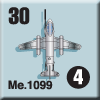 
The Luftwaffe's Weserflug P.1003 was a tilt-rotor
transport plane very similar in concept to
the Boeing V22 Osprey. An engine in the middle
of the plane powered two propellers that
could be tilted to drive the plane like a
conventional propeller or allow it to hover
like a helicopter. The German version never
got past the planning stage; the Boeing plane
began development in 1981 and finally entered
a combat zone in October 2007. There's no
reason think the German team would have done
any better, but the plane was too bizarre
to leave out of the game and it makes for
interesting air assault scenarios.
Just like the tank design bureaus, aircraft
studios kept their young talent working on
jet projects that could not possibly see
actual production to keep the staff out of
the draft. One of these projects was a jet-powered
ground attack plane designated Me.1099. In
its anti-tank configuration it boasted an
automatic 55mm cannon.
German Giant Tanks
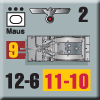 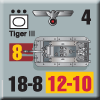 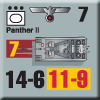
We know what the fans want: huge German
tanks to take on the huge American and Soviet
tanks from Iron
Curtain. And Secret
Weapons provides them.
There is of course Panzer Maus, the huge
heavily armored but terrifically slow behemoth.
The tank's hitting power is unquestioned;
just how it will fare when it's even slower
than enemy infantry is a fine question for
the scenarios to answer. Slightly better
balanced is the E-100 super-heavy tank, designated
here as the Tiger III. The beast has an even
bigger gun, not quite as much armor but better
speed (if you can call it that).
A far more lethal opponent for Allied armor
would have been the Panther II, sort of a
mixture of the Tiger II and original Panther
with a smaller turret mounting an 88mm gun.
It's usually stated that only one was partially
completed, but my late friend Belton Cooper,
an ordnance officer with the U.S. 3rd Armored
Division, had a photo taken near Paderborn
of a destroyed German tank that sure looked
like one.
The Germans also get two types of anti-aircraft
tank, the Coelian and the Kugelblitz. These
featured a "ball" turret with either
37mm or 20mm guns, and would have been formidable
weapons against infantry as well.
British Giant Tanks
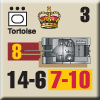 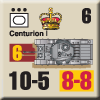 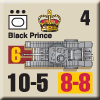
When we did Iron
Curtain, I really wanted
to add British post-war tanks to the mix
but there just didn't seem to be enough room — the
scenarios were supposed to feature huge masses
of armor and the American and Soviet machines
ate up all the space on the counter sheets.
In Secret
Weapons, the Brits are here and
they are exceedingly well-armed. The Centurion
would become the main battle tank of many
of the world's armies for the next 40 years;
a handful of them are still in service today.
With the very effective 17-pounder and good
protection, the Centurion was slower than
most foreign tanks but as a whole most British
tank designs were not as fast as those of
other nations.
The Centurion's success made the Black Prince
infantry tank obsolete as soon as it entered
service. A development of the Churchill tank,the
Black Prince also had a 17-pounder gun and
a level of protection similar to the Centurion,
but like all British infantry tanks it was
quite slow.
Even slower was Britain's answer to the
same questions that gave the U.S. Army its
T28 assault gun: a massively armored vehicle
designed to attack fortifications. The Tortoise
was slow and heavily armored, with new 32-pounder
anti-tank gun, and ultimately never saw combat.
Other Weapons
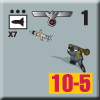 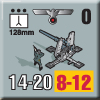
The missile age reaches Panzer
Grenadier for the first but not the last time, with
the German X7 "Little Red Riding Hood" wire-guided
anti-tank missile. They're very effective,
and also give air assault forces a serious
anti-tank capability. The X7 may have seen
action in April 1945 near the Neisse River,
claiming a pair of Soviet T-34/85 tanks.
Or perhaps not — the claim is disputed.
Missiles became the tank-killing weapons
of choice because anti-tank guns had simply
become too large and heavy for battlefield
use. A prime example is the German 128mm
gun, derived from a very effective anti-aircraft
weapon. Armor-piercing performance was not
far different from the deadly 88mm gun, but
the bigger weapon could kill enemy tanks
at a much longer range and it fired a heavier
high-explosive shell. It was also so heavy
that it could not be moved without serious
effort — in game terms, the 128mm piece
has no limbered side as it is immobile.
Click here to order Panzer
Grenadier: Secret Weapons now! |
